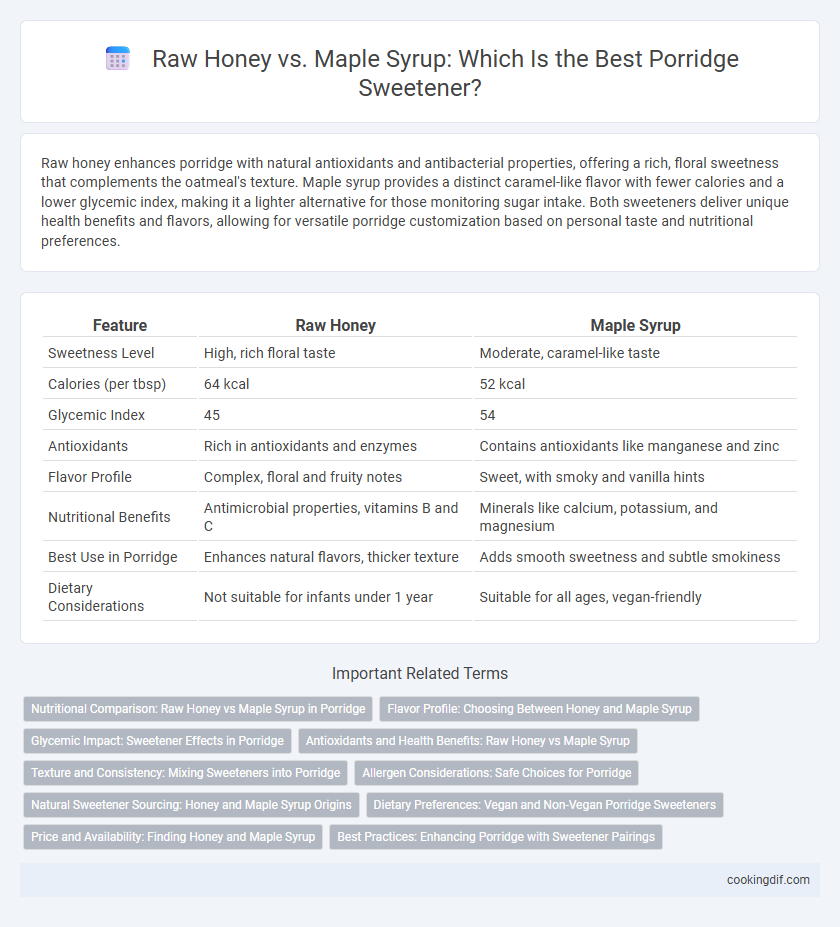Raw honey enhances porridge with natural antioxidants and antibacterial properties, offering a rich, floral sweetness that complements the oatmeal's texture. Maple syrup provides a distinct caramel-like flavor with fewer calories and a lower glycemic index, making it a lighter alternative for those monitoring sugar intake. Both sweeteners deliver unique health benefits and flavors, allowing for versatile porridge customization based on personal taste and nutritional preferences.
Table of Comparison
| Feature | Raw Honey | Maple Syrup |
|---|---|---|
| Sweetness Level | High, rich floral taste | Moderate, caramel-like taste |
| Calories (per tbsp) | 64 kcal | 52 kcal |
| Glycemic Index | 45 | 54 |
| Antioxidants | Rich in antioxidants and enzymes | Contains antioxidants like manganese and zinc |
| Flavor Profile | Complex, floral and fruity notes | Sweet, with smoky and vanilla hints |
| Nutritional Benefits | Antimicrobial properties, vitamins B and C | Minerals like calcium, potassium, and magnesium |
| Best Use in Porridge | Enhances natural flavors, thicker texture | Adds smooth sweetness and subtle smokiness |
| Dietary Considerations | Not suitable for infants under 1 year | Suitable for all ages, vegan-friendly |
Nutritional Comparison: Raw Honey vs Maple Syrup in Porridge
Raw honey contains higher levels of antioxidants and trace enzymes compared to maple syrup, contributing to enhanced immune support. Maple syrup offers a lower glycemic index, providing more stable blood sugar levels when used as a porridge sweetener. Both sweeteners supply essential minerals like manganese and zinc but in varying amounts, with maple syrup typically containing higher manganese content.
Flavor Profile: Choosing Between Honey and Maple Syrup
Raw honey offers a rich, floral sweetness with complex notes of pollen and beeswax that deepen the porridge's flavor. Maple syrup provides a smooth, caramel-like taste with hints of vanilla and earthiness, creating a warm and comforting blend. Selecting between the two depends on whether you prefer the vibrant, aromatic qualities of honey or the mellow, woody undertones of maple syrup to complement your porridge.
Glycemic Impact: Sweetener Effects in Porridge
Raw honey and maple syrup both serve as popular natural sweeteners for porridge, but they differ significantly in glycemic impact. Raw honey typically has a glycemic index (GI) ranging from 45 to 64, leading to moderate blood sugar spikes, whereas maple syrup has a GI around 54, offering a slightly steadier glucose response. Choosing between these sweeteners can influence the overall glycemic load of porridge, making raw honey more suitable for those seeking moderate blood sugar elevation and maple syrup preferable for a more balanced glycemic effect.
Antioxidants and Health Benefits: Raw Honey vs Maple Syrup
Raw honey contains higher levels of antioxidants such as phenolic compounds and flavonoids, which contribute to its anti-inflammatory and immune-boosting properties, making it a beneficial sweetener for porridge. Maple syrup also provides antioxidants, particularly manganese and zinc, supporting metabolic health and antioxidant defense, but generally offers lower antioxidant content compared to raw honey. Choosing raw honey enhances porridge with more potent health benefits linked to its rich antioxidant profile and natural enzymes.
Texture and Consistency: Mixing Sweeteners into Porridge
Raw honey blends smoothly into warm porridge, adding a thick, velvety texture that enhances creaminess without overpowering the base. Maple syrup integrates with a more fluid consistency, creating a lighter, more liquid finish that lightly coats each spoonful. The choice between raw honey and maple syrup affects porridge's mouthfeel, balancing sweetness with desired thickness.
Allergen Considerations: Safe Choices for Porridge
Raw honey is a natural sweetener with minimal allergenic potential, making it a safe choice for most individuals when sweetening porridge. Maple syrup is also hypoallergenic and free from common allergens like nuts or gluten, providing a safe alternative for those with food sensitivities. Both options offer safe and natural sweetening for porridge without introducing common allergens.
Natural Sweetener Sourcing: Honey and Maple Syrup Origins
Raw honey is harvested directly from beehives, ensuring it retains natural enzymes, antioxidants, and floral flavors unique to specific regions, which enhances the depth of porridge flavor. Maple syrup is tapped from the sap of sugar maple trees primarily in North America, concentrating natural sugars through evaporation while preserving minerals like manganese and zinc that add subtle earthy notes. Choosing between raw honey and maple syrup as porridge sweeteners depends on desired taste profiles and nutrient benefits linked to their distinct natural sourcing and production methods.
Dietary Preferences: Vegan and Non-Vegan Porridge Sweeteners
Raw honey offers a rich, natural sweetness and contains antioxidants but is unsuitable for strict vegans due to its animal origin. Maple syrup, derived from tree sap, is a plant-based, vegan-friendly sweetener rich in minerals like manganese and zinc. Choosing between these options depends on dietary preferences, with maple syrup favored by vegans and raw honey preferred by non-vegans seeking natural sweeteners.
Price and Availability: Finding Honey and Maple Syrup
Raw honey typically costs more per ounce than maple syrup but offers a longer shelf life with natural antimicrobial properties. Maple syrup is generally more affordable and widely available in grocery stores and supermarkets, especially in North America. Both sweeteners are accessible year-round, although local raw honey can be pricier and seasonally harvested, while pure maple syrup availability is consistent due to mass production.
Best Practices: Enhancing Porridge with Sweetener Pairings
Raw honey and maple syrup both enhance porridge with distinct flavor profiles and nutritional benefits; raw honey offers antimicrobial properties and a rich floral sweetness, while maple syrup provides antioxidants and a smooth, caramel-like taste. Best practices for sweetener pairings include balancing sweetness intensity and complementing additional toppings such as nuts, seeds, or fresh fruits to create a harmonious texture and flavor. For optimal health benefits and taste, use small amounts of raw honey or maple syrup, adjusting to personal preference and dietary needs.
Raw honey vs maple syrup for porridge sweetener Infographic

 cookingdif.com
cookingdif.com